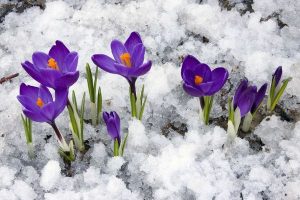Nothing says, “Spring is on its way!” like a blooming Crocus.
These colorful, cup-shaped flowers signal the arrival of warm weather and blossoming gardens. The first crocus sighting is always a joyful surprise. Time to get back out in the yard and begin a brand new season of planting and harvesting! While their presence is fleeting, we always eagerly await their return the following year.
In celebration of this fabulous seasonal flower, we’re sharing some amazing facts about crocuses with the Humble Gardener community.

- Natural insulation. The reason crocuses can weather out the occasional frost and even a light dusting of snow? Their leaves and petals are covered by a waxy cuticle.
- Spring blooming crocuses come in two types. There’s the species (snow crocus) and hybrid (giant Dutch). If you plant both, you’ll ensure a longer crocus season and plenty of variation in coloring and size. Species crocuses are usually the first to bloom, and display uniquely colored petals. Hybrids bloom a little later and produce larger flowers.
- Saffron is a product of the crocus. This popular spice is a product of C. sativus, the Saffron crocus. Each plant produces three red stigmas, which are dried and then used for coloring and seasoning in flavorful dishes like paella. 90% of the world’s saffron is harvested in Iran, and it’s one of the most expensive and precious spices on the planet.
- It’s found the world over. Crocus is at home in meadows, forests, and on mountain peaks. It thrives in Southern Europe, Central Asia, China, Middle East and Africa. There are 80 different crocus species that originate in all different parts of the world.
- Rooted in Greek mythology. The word “crocus” comes from the Greek word króki, which means weft, the thread used for weaving on a loom. But the Greek origins of crocus extend to mythology, to the story of Mercury (Hermes) and Krókos. The two friends were throwing a Frisbee back and forth one day, so the tale goes, when Mercury’s aim failed and he struck Krókos on the head, a fatal wound. As Krókos lay dying, three drops of blood spilled from his head and onto the center of a flower, the three stigmata of his namesake plant.
- Harvesting crocuses is tough work. It takes 85,000 flowers to accumulate just one kilogram of crocuses. And gathering must be done by hand, ideally between dawn and 10 a.m.


